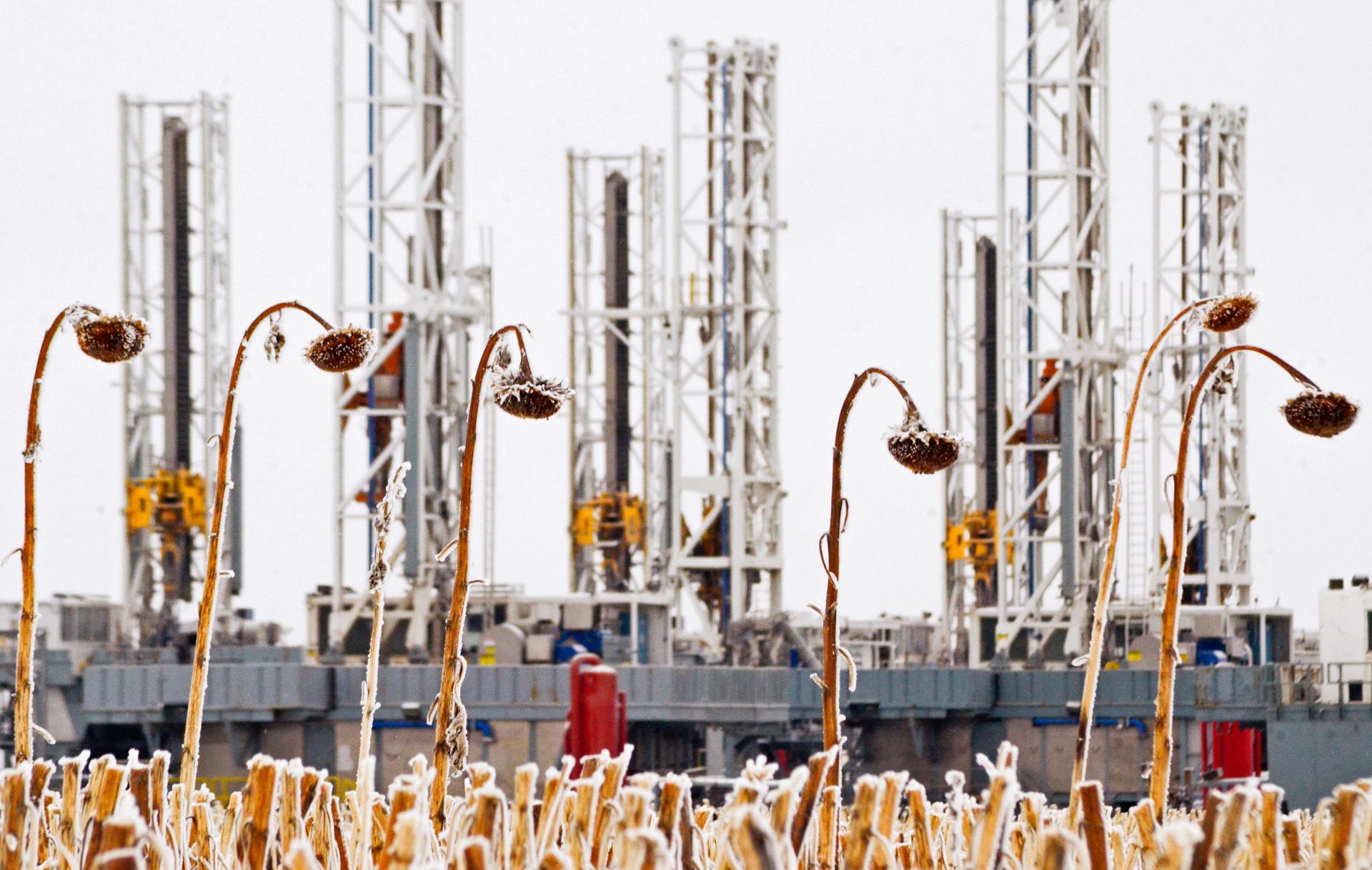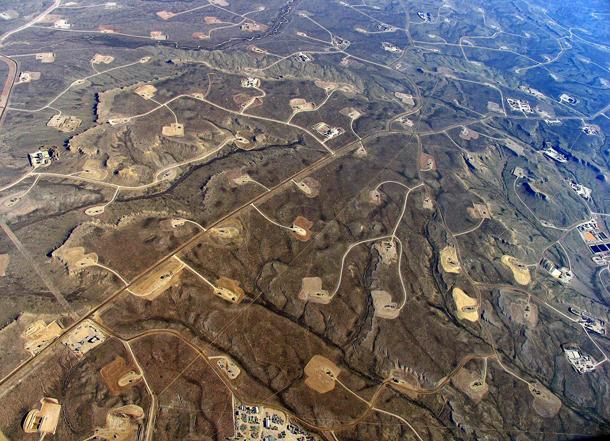Fracking causes environmental damage and birth defects, new study shows
Fracking pads and roads, seen here from the air, can turn a rural landscape into a network of industrial infrastructure.
Fracking has revolutionized the extraction of oil and gas in just a few years, but this highly efficient method comes with environmental and health risks. Now, a new metastudy details its adverse effects on the local environment, the climate and human health.
The new report, published by Physicians for Social Responsibility and Concerned Health Professionals of New York, brings together the findings of more 1,700 studies, articles and reports tying fracking activities to a host of health problems including birth defects, cancer and asthma.
Related: Fracking is on the rise in Pennsylvania. So are radon levels. Are the two connected?
It’s the sixth edition of a report originally published in 2014, which helped inform New York State’s decision to ban fracking. A group of public health professionals that included Sandra Steingraber, a professor of environmental studies and sciences at Ithaca College, had wanted to make sure sound science was part of that decision.
“So, we went to work, translating the science into plain English for our political leaders, members of the press and, most importantly, people in frontline communities who are going to be compelled to endure the risks that fracking brings to people’s health,” Steingraber says.
Related: In Argentina, enormous fracking potential and opposition to match
“When we first did this, we didn’t call it a compendium, we called it a memo,” she says, “because there were only nine studies in the peer-reviewed literature. When we finally banned fracking in New York in December 2014, we had an edition of the compendium with 400 studies. At that point, people all over the world were … thinking about fracking — whether to allow it or not — so our compendium was in great demand. So we’ve kept going with it.”
Fracking (or, hydraulic fracturing) works by forcing water, sand and chemicals into shale rock at high pressures, allowing fossil fuel companies to extract oil and gas that can’t be reached with conventional wells. The study examined fracking’s effect on a wide range of parameters, including air pollution, water pollution, radioactivity, social disruption and climate change.
“Across all these data we saw a plethora of recurring problems and harms, and we uncovered no regulatory framework that could avert these harms. In other words, there’s no evidence that fracking can operate without threatening public health directly or without imperiling climate stability, on which public health, of course, depends.”
“Across all these data we saw a plethora of recurring problems and harms, and we uncovered no regulatory framework that could avert these harms,” Steingraber says. “In other words, there’s no evidence that fracking can operate without threatening public health directly or without imperiling climate stability, on which public health, of course, depends.”
Air pollution is an ever-present by-product of fracking, including methane, which is a powerful greenhouse gas, and ground-level ozone, which Steingraber calls “a killer.”
Science clearly shows that ground-level ozone contributes to stroke risk, premature birth, heart attack and asthma, among other things, she explains. When her research group looked at public health effects measured directly, they saw them occurring at higher than normal rates in places with a lot of fracking activity.
The most troubling of these, Steingraber says, is the effect on pregnant women who live near drilling and fracking operations. These women are at higher risk for poor birth outcomes, including premature birth, certain kinds of birth defects and small-for-date births — infants born small for the number of months of pregnancy.
Water contamination is also a proven result of fracking, Steingraber says. Fracking uses fresh drinking water sources to shatter the shale underground, releasing the bubbles of methane — natural gas — and oil trapped inside the rock. “When that water comes back up again, it’s contaminated not only with toxic fracking chemicals that were added in the first place, but there is also a whole periodic chart of toxic chemicals down in the shale — things like heavy metals, arsenic, barium, strontium, uranium,” Steingraber explains. “Some of these things, like radium and radon, are actually radioactive.”
This raises the difficult problem of how to dispose of toxic wastewater. Standard practice is to re-inject it into the ground, but this raises the risk of contaminating drinking water aquifers, which the wastewater has to be pushed through. In addition, because lubricating chemicals are added to fracking fluid, the technique can actually lubricate fault lines and trigger earthquakes. Some areas in the United States, such as Oklahoma, have seen a dramatic and unexpected rise in seismic activity, which is likely connected to wastewater disposal. A whole section of the new report is dedicated to the public health and safety risks around increased seismic activity, Steingraber says.
As is commonly the case with extractive industries, there is an environmental justice component to fracking and health impacts.
Fracking infrastructure and fracking well pads are disproportionately sited in communities of color, poor communities and rural communities that can offer the least resistance — communities where people don’t necessarily “have friends in Congress” or access to effective legal assistance, Steingraber notes.

Climate change is the big theme of the sixth edition of the compendium. Data clearly show that methane is surging in the atmosphere across the globe, a phenomenon that began to rise rapidly in 2007, Steingraber says. Methane is 86 times more powerful over a 20-year time frame than carbon dioxide and “twenty years is about the length of time we have left to really get the climate stabilized and decarbonize.”
“Increasing evidence suggests that North American fracking operations are driving a lot of that surge,” she adds. “And we’re discovering that fracking operations and all their attendant infrastructure — the pipelines, the compressor stations, the distribution pipes that bring it into your home —are far more leaky than we formerly appreciated and there are no good fixes for this problem. All of this is quite alarming, showing us that fracking is absolutely incompatible with climate stability.”
Steingraber disputes the notion that natural gas is a so-called bridge fuel to a clean-energy future.
“That’s been an industry talking point since the very beginning,” she says. “There was never really a lot of data to suggest that natural gas worked that way, but at this late stage in the climate crisis we know that’s absolutely not the case.” One reason the bridge metaphor doesn’t really make sense, Steingraber adds, is that “we’re already on the other side of the water.”
“We have renewable resources that are deployable now, in the form of solar, wind and water power that can be backed up with battery storage, obviating the need for fracking,” she points out. “So, fracking is no longer a bridge. It might have been a bridge 80 or 90 years ago. Today, it’s a wrecking ball that is swinging at our climate.”
This article is based on an interview that aired on PRI’s Living on Earth with Steve Curwood.
